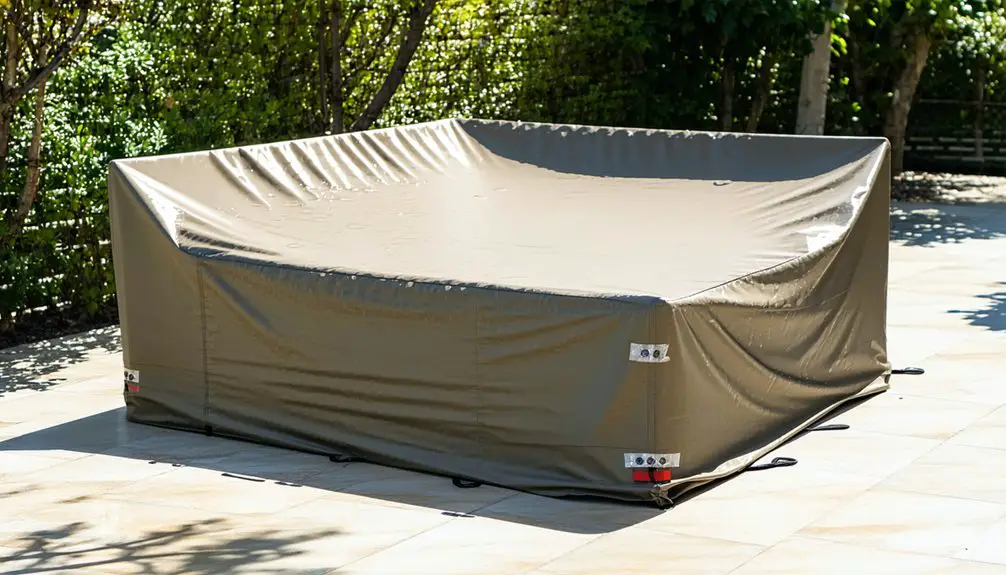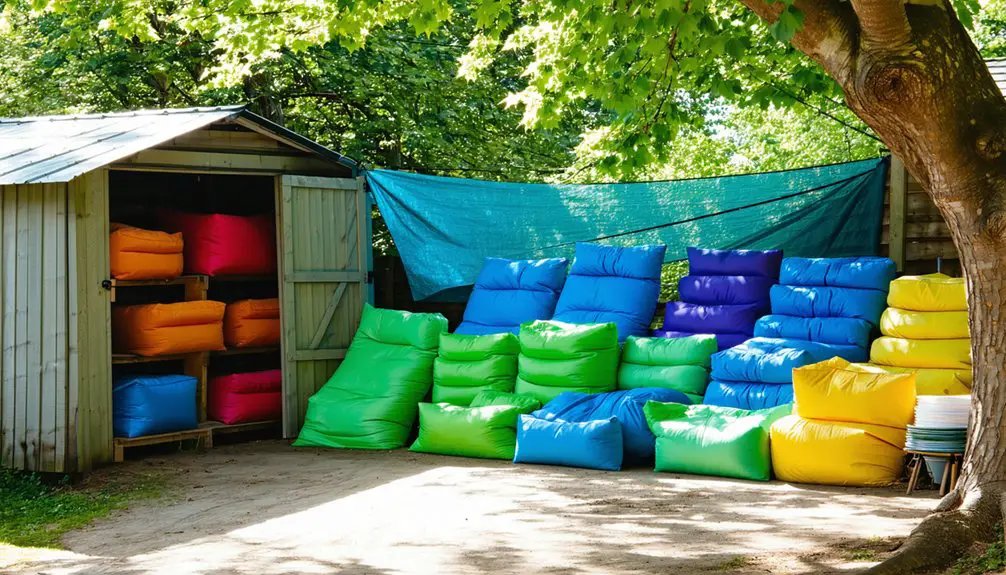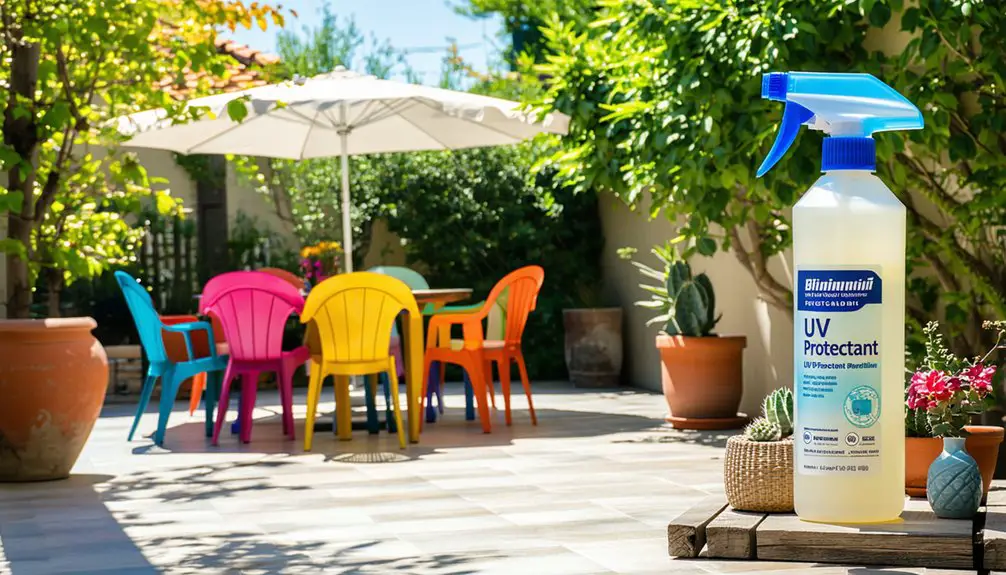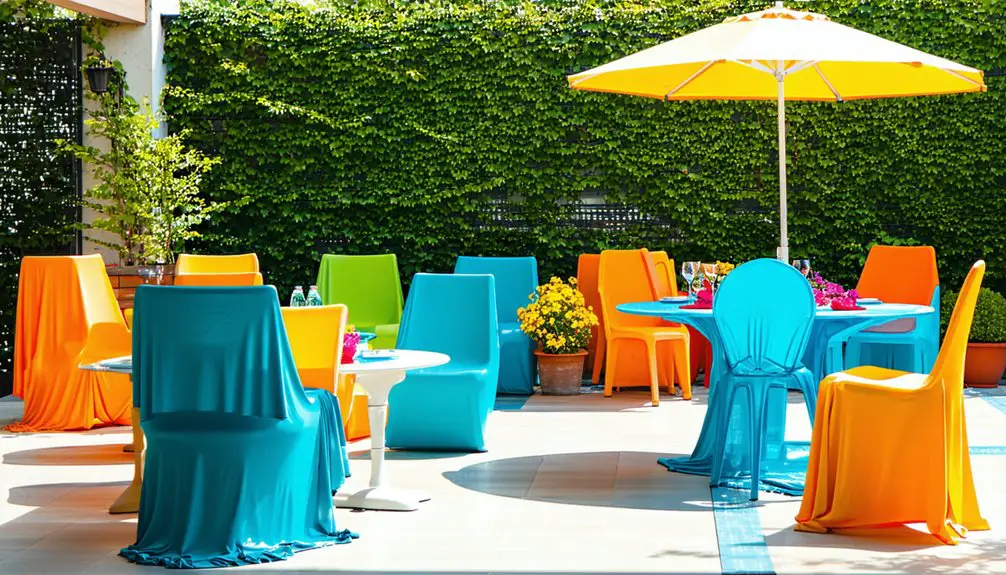To protect your outdoor plastic furniture from harmful UV rays, start by choosing UV-resistant materials like HDPE or TPO. Applying protective coatings, such as UV sprays or sealants, can also enhance durability. Using breathable, UV-resistant covers prevents moisture buildup while providing solid protection from the sun. Creating shade with awnings or canopies and strategically placing furniture under natural shade can help reduce direct sun exposure. Regularly clean and maintain your furniture, and store it properly during off-seasons. These strategies can significantly extend the lifespan of your outdoor furniture. There's more to explore about keeping your furniture in top shape!
Key Takeaways
- Choose UV-resistant materials like HDPE and TPO for outdoor plastic furniture to ensure durability and prevent color fading over time.
- Apply UV-resistant coatings and protectants to surfaces regularly, following manufacturer instructions for optimal protection and longevity.
- Store furniture in dry, covered areas during off-seasons to minimize sun exposure and prevent moisture damage.
- Utilize breathable protective covers that fit snugly to shield furniture from UV rays while preventing moisture buildup and mold.
- Implement shade solutions like awnings or gazebos to provide consistent protection from direct sunlight and prolong furniture lifespan.
Choosing UV-Resistant Materials
When you're selecting materials for outdoor furniture, choosing UV-resistant options is crucial for ensuring longevity and maintaining appearance. UV-resistant plastics, like high-density polyethylene (HDPE), stand out for their durability and ability to withstand harsh outdoor conditions. These materials prevent color fading and degradation, making them ideal for prolonged sun exposure, rain, and temperature fluctuations. Additionally, furniture designed to be UV resistant generally has a longer lifespan in outdoor conditions.
Using UV-resistant plastics extends the lifespan of your outdoor furniture while reducing the weathering effects that cause fading and brittleness. They maintain color vibrancy and structural integrity over time, enhancing the overall aesthetic appeal. Compared to traditional plastics, UV-resistant options are far more durable in sunny areas, saving you from frequent replacements or repairs. Furthermore, they can withstand mold and mildew, which can degrade the material and pose health risks.
While materials like teak and cedar wood are durable, they require more maintenance than UV-resistant plastics. Metals such as aluminum and stainless steel offer UV protection but lack the lightweight convenience of plastics. Additionally, fabric materials like Sunbrella need extra UV protection sprays, unlike inherently UV-resistant plastics.
Ultimately, selecting UV-resistant materials not only reduces your environmental impact but also proves to be cost-effective in the long run.
Applying Protective Coatings
Applying protective coatings to your outdoor furniture is an essential step in enhancing its UV resistance and overall durability.
To get started, you'll want to prepare the surface properly. Here's what you need to do:
- Clean the Furniture: Remove dirt, dust, and debris. Make sure the surface is completely dry before applying any coatings.
- Select the Right Coating: Depending on the material, choose UV-resistant sprays for fabrics, water-repellent sealants for wood, or rust-resistant coatings for metal.
- Apply Evenly: Use sprays for fabric and brushes for sealants or varnishes, ensuring even coverage across all surfaces. Regularly applying UV protection is essential for preserving your investment in outdoor furnishings.
Always follow the manufacturer's instructions for application and drying times, and work in a well-ventilated area.
After applying the coatings, regularly inspect them for wear and reapply as needed, typically every 18-24 months.
By taking these steps, you'll protect your outdoor furniture from the harsh effects of UV rays and extend its lifespan significantly.
Using Protective Covers

When you choose protective covers for your outdoor furniture, look for breathable materials that prevent moisture buildup and mold. Ensuring a proper fit is crucial, as it keeps your furniture shielded from UV rays and other elements. With the right covers, you can significantly extend the life of your outdoor investments. Additionally, selecting covers made from materials that block 95-99% of UV radiation will provide enhanced protection against sun damage.
Breathable Material Benefits
Breathable materials in protective covers offer significant advantages for outdoor furniture, ensuring your investment remains in prime condition. Using covers made from materials like polyester, vinyl, and canvas not only protects your furniture but also enhances its longevity.
Here are three key benefits of breathable materials:
- Moisture Management: Breathable covers allow for rapid evaporation of trapped moisture, reducing the risk of corrosion and damage. Mesh vents enhance airflow, preventing mold and mildew buildup.
- UV Protection: Fabrics treated with UV-resistant coatings block harmful rays, preventing fading and damage. This helps retain the color of your furniture and extends its life. Additionally, many covers made from polyester and vinyl are designed for high durability against various weather conditions.
- Durability: High-quality materials are designed to withstand harsh weather conditions, ensuring long-term protection. Plus, many breathable covers are easy to store and maintain, making them convenient for everyday use.
Investing in breathable protective covers not only safeguards your outdoor furniture but also keeps it comfortable and ready for use.
Ensuring Proper Fit
Choosing the right protective cover is just as important as selecting breathable materials. A proper fit ensures maximum coverage and protection against harmful UV rays. When your outdoor furniture covers all parts, it prevents uneven fading and damage, significantly reducing the risk of sun exposure to uncovered areas. This not only enhances the structural integrity of your furniture but also maintains its aesthetic appeal.
Opt for UV-resistant materials like polyester or polyethylene, as they can block up to 95-99% of harmful rays. Tightly woven fabrics provide better protection, so choose covers that fit snugly around your furniture. Custom fit options are available for various outdoor furniture sizes and shapes, ensuring you get the best protection. Additionally, high UPF ratings indicate that the materials used in your covers are effective at blocking UV radiation.
Installation and removal should be straightforward, encouraging you to use the covers regularly. Seasonal adjustments can help maintain that protective barrier year-round.
Providing Shade
Providing shade is essential for protecting your outdoor plastic furniture from harmful UV rays and prolonging its lifespan. By incorporating effective shade solutions, you can ensure your furniture remains in great condition while enjoying the outdoors.
Here are three effective ways to provide shade:
- Using Gazebos: Gazebos offer a permanent shade solution, customizable with various roofing materials. They not only protect against UV rays but also enhance your backyard's aesthetic while providing a designated seating area.
- Installing Awnings: Awnings can be fixed or retractable, giving you control over specific shaded areas like patios or decks. They reduce UV exposure effectively and can be adjusted throughout the day to optimize shade.
- Utilizing Pop-Up Canopies: For quick and temporary shade, pop-up canopies are ideal. They're easy to set up and take down, adjustable in height, and compact for storage. Perfect for events or seasonal use!
Incorporating these shade options can help maintain your outdoor plastic furniture, allowing you to enjoy your space without worry.
Storing Furniture

When it comes to protecting your outdoor plastic furniture, storing it properly during the off-season is crucial. Start by finding a suitable storage location, such as a shed or garage, to shield your furniture from direct sunlight. If indoor storage isn't an option, a covered patio or gazebo works too.
Make sure the area is dry and free from pests, and keep it clean to prevent damage. Timing is key, so store your furniture during off-seasons, especially during peak sun months to reduce UV exposure. If you'll be storing it for an extended period, check on your furniture occasionally.
Remember to store cushions and upholstered parts separately to maintain their condition. Before storage, clean your furniture thoroughly to avoid dirt buildup. Applying a protective coating or sealant adds an extra layer of defense.
Use breathable covers to prevent moisture accumulation, and disassemble pieces when possible for efficient storage. Durable, UV-resistant covers can shield against sun and rain, while storage bins work great for smaller items.
Lastly, secure any loose parts to avoid loss or damage, ensuring your furniture stays in top shape for its next use.
Regular Maintenance
Regular maintenance of your outdoor furniture is essential to ensure its longevity and appearance. By establishing a routine, you can prevent damage and keep your furniture looking its best.
Here are three key steps to follow:
- Regular Cleaning: Wipe away leaves and debris regularly. Use a mixture of 1 tablespoon of natural liquid dish wash detergent and warm water in a bucket. Scrub with a soft sponge and rinse thoroughly to avoid soap residue.
- Protective Measures: Use furniture covers that fit snugly to keep dirt and debris at bay. Apply UV protection sprays like Scotchgard Water and Sun Shield to guard against sun damage.
- Inspection and Repair: Check for any small cracks or chips and repair them immediately using plastic furniture repair kits. This helps maintain the structural integrity of your pieces.
Additional Tips for Longevity

Maintaining your outdoor furniture is just the beginning of ensuring its longevity. To protect against harmful UV rays, consider using UV protectant sprays that form a barrier on surfaces.
Employ plastic covers, like PVC, to shield your furniture from intense sunlight, especially during harsh weather. When conditions are extreme, store your furniture indoors or utilize protective covers for added security.
Investing in collapsible furniture allows for easy storage when not in use, and wall hangers can keep these pieces neatly tucked away.
Strategically placing your furniture can also minimize sun exposure. Position items near buildings or under trees for natural shade.
Avoid areas with direct sunlight all day, particularly for upholstered and plastic pieces. Retractable awnings can control sun exposure effectively, too.
Lastly, enhance protection with UV-resistant paints or clear coats. For upholstered fabrics, applying Scotchgard Water and Sun Shield will help.
Select materials known for their UV resistance, like thermoplastic olefin (TPO) or marine-grade acrylic fabric for awnings.
Frequently Asked Questions
How Do UV Rays Affect Different Types of Plastic Furniture?
UV rays weaken plastics like polyethylene, polypropylene, and PVC, causing discoloration, brittleness, and loss of strength. You'll notice fading and structural issues over time, impacting both the look and durability of your furniture.
Can UV Protection Methods Be Combined for Better Effectiveness?
Absolutely! You can combine multiple UV protection methods for better effectiveness. Using UV-resistant materials alongside shade solutions and proper storage techniques maximizes your furniture's lifespan and keeps it looking great for years to come.
What Are the Signs of UV Damage on Plastic Furniture?
You'll notice signs of UV damage on plastic furniture through a chalky appearance, fading colors, dullness, cracks, and brittleness. Look for structural weaknesses like warping or loose parts to assess overall deterioration.
Are There Eco-Friendly UV Protection Options Available?
Yes, you've got eco-friendly UV protection options! Using furniture covers, storing items during peak sun, and choosing UV-resistant materials can all help keep your outdoor furniture safe without harming the environment.
How Long Do UV Protectant Sprays Typically Last?
UV protectant sprays typically last 3 to 6 months, but factors like sunlight exposure and weather conditions can shorten this duration. Regular maintenance and proper application can help extend their effectiveness and longevity.

